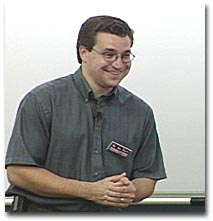Practice makes perfect
Okay, I am not advocating that you get right out there and go to Political Pundit School, but there's is a key point or two in this article that make sense.
Media training isn't new, and even though the arenas may change, the fundamental prinicples still apply: When it is your name and reputation on the line, you need to be clear and concise in your messaging.
 This author is recounting his trip to a hardcore boot-camp for television talking heads. Much of the advice runs counter to what we generally recommend... but then again, most of our training clients aren't working in a place where you have to shout to be heard, and confrontation rules the day.
This author is recounting his trip to a hardcore boot-camp for television talking heads. Much of the advice runs counter to what we generally recommend... but then again, most of our training clients aren't working in a place where you have to shout to be heard, and confrontation rules the day.The one skill that does pertain is how to incorporate your key messages into a conversation:
"I ran out of things to say. This is a problem that plagues inexperienced pundits, but Masters has an easy solution: come up with a list of talking points and commit them to memory. 'To train yourself,' he went on, 'be prepared to weave your points into any conversation. It's a fun thing to practice at cocktail parties.'"
This can be a difficult skill to acquire, because there are so many precursor skills to learn and few people teaching those basics.
I like to think of this challenge according to the "hooks" of the subject.
Listen for a commonality with the subject of your key message.
Listen for a commonality with the action you are proscribing.
Listen for a commonality with the object of the action.
Subject. Verb. Object.
Someway, somehow, you can usually tie one of your points to someone else's comments. It may require some adjustments, either in impact or in scale:
"Masters counsels clients to either broaden the question or narrow it, depending on what suits their partisan purposes. Was Bush helped by strong job numbers this month? Then the broader issue is the continual outsourcing of American jobs. Are Hillary's favorability ratings on the rise? No problem: in red states she still ranks below avian flu."Finally, there is the issue of getting the most out of the message you have constructed. Master storyteller Wayne Freedman often coaches the power in the "Rule of 3s," and educators have long taught in three-steps: instruction, application, and correction. "Three"s are so natural to us, we tend to hear them or look for them even when they aren't there. (I know there's someone in your office that always asks 'Who's next?' after two prominent celebrities die.) Use that to your advantage:
"People think and process information in groups of three," he explained. "Larry, Curly, Moe. Beginning, middle, end. Anytime you answer a question, first hit your message, then enhance it with a story or an anecdote, then hit it again. Narrow, wide, narrow."


 From time to time, we'll highlight the good and the bad in the world of public relations -- including an analysis of missed opportunities to do better. We'll discuss some of the strategies that were used (or
From time to time, we'll highlight the good and the bad in the world of public relations -- including an analysis of missed opportunities to do better. We'll discuss some of the strategies that were used (or 

0 Comments:
Your two cents...
<< Home